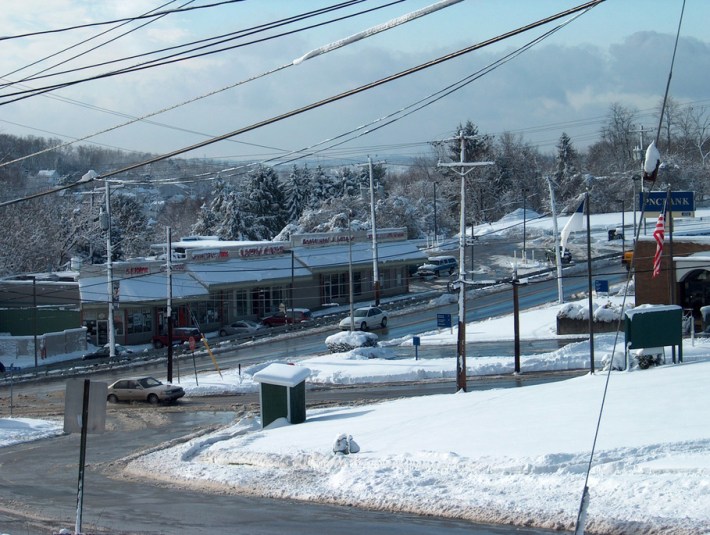Poverty is no longer a predominantly urban problem -- and the suburbs are no longer the refuge of the upper classes. There are now almost 3 million more poor people living in suburbs than in cities, according to a new book, "Confronting Suburban Poverty in America," by Elizabeth Kneebone and Alan Berube of the Brookings Institution. While cities still have a much higher poverty rate, poverty in the suburbs is growing twice as fast: Between 2000 and 2011, the suburban poor population grew by 64 percent, compared to 29 percent in cities.
That means more people living without cars in places designed exclusively for cars. In the suburbs, destinations are farther apart and getting to many places involves traveling on wide, high-speed roads where walking or biking is especially dangerous. Transit access is spotty and infrequent, where it exists at all. And providing transportation services to the poor in spread-out areas is less efficient and more expensive than in compact cities.
“Overall, in the nation’s largest metropolitan areas, 700,000 households do not have a vehicle and are not served by public transit of any kind, and 95 percent of those households are suburban,” the authors write.
Kneebone and Berube tell the story of Penn Hills, Pennsylvania, which used to be a middle-class bedroom community for workers at the Westinghouse Electric Company and other thriving businesses in the Pittsburgh area. Diminished employment opportunities have reduced the population by more than a quarter and increased the poverty rate from 8 to 11 percent:

Among the more pressing problems facing the growing low-income population in Penn Hills is access to transportation. The suburb covers nineteen square miles, has more than twenty distinct neighborhoods, and is traversed by an interstate highway, a few major state roads, and a series of local roads with only a few sidewalks that wind their way up and down the hilly terrain. Infrastructure in some parts of the township resembles that of a rural community more than a major metropolitan suburb. More often now, residents must navigate these byways without a car. By 2008–10, almost one in ten (about 1,700) Penn Hills households lacked access to a vehicle, notably more than three decades earlier, when the local population was much larger.
Public transportation service, unfortunately, is dwindling. Sociologist Alexandra Murphy profiled a predominantly black, low-income Penn Hills neighborhood where many residents have no car and many more cannot keep up with the expenses of the maintenance, repairs, and gas required to ensure that their vehicles run reliably. One bus line serves the community but comes only a few times in the morning (into the city) and a few times in the late afternoon to early evening (back out of the city). As Murphy described, budget cuts at the Allegheny County Port Authority have left many more of Penn Hills’s neighborhoods and residents with limited public transit options, including none on the weekends. These cuts have left many residents struggling to gain and maintain employment, particularly those working late shifts in the city or trying to get to jobs in neighboring suburbs.
Rather finding a better quality of life in the suburbs, the growing population of poor suburban residents find themselves isolated and less able to access public services. Getting to Head Start or the WIC office is difficult for families without reliable access to transportation, Berube and Kneebone write.
Kneebone has also done extensive research on job sprawl. More than 43 percent of jobs in metropolitan areas are located more than ten miles from downtown. “Moreover, the sectors most likely to employ less skilled workers — retail and wholesale trade, leisure and hospitality, personal services — are even more suburbanized than average,” the authors write. “These trends might suggest better access to employment opportunities for the growing number of low-income residents in suburbia. But that is often not the case. In many metropolitan areas, growth in suburban poverty and growth in suburban jobs occur in different parts of the region.”
And all too often, those neighborhoods aren’t connected by transit.
While the lower cost of housing in the suburbs is often the draw for low-income families, the higher cost of transportation can sneak up on them. In the 25 largest metro areas, low-income households spend an average of 27 percent of their income on transportation costs.
In suburban areas, even poor residents get to work by driving alone 74 percent of the time. And low-income people pay more for their cars than their higher-income counterparts. Auto loans cost lower-income drivers an average of two percentage points more, and insurance costs them an average of 40 percent more. Plus, they often have older vehicles that require more repairs, which low-income families often can’t pay for. Researcher Alexandra Murphy found that many Penn Hills residents “would go through periods with one or more cars out of service because of the high cost of repairs.”
Transit would help families who find themselves in this situation, but it often doesn’t reach them – at least not in any useful way. While 77 percent of working-age residents in low-income suburban neighborhoods have at least one transit stop within three-quarters of a mile from home, these residents can reach only 4 percent of metropolitan jobs within a 45-minute commute.
In part, that’s because the traditional hub-and-spoke transit model, designed to bring suburban commuters in and out of downtown (where the jobs used to be), is increasingly obsolete. Suburb-to-suburb travel is indirect and time-consuming.
Berube and Kneebone say that public policy hasn't kept pace with the rise of poverty in the suburbs. People still largely see it as an urban problem, and the vast majority of funds available for anti-poverty programs are located in cities. But high-quality transit service is an anti-poverty program, and one that is desperately needed in the suburbs.





